Evidence for Persistence of Ectromelia Virus in Inbred Mice, Recrudescence Following Immunosuppression and Transmission to Naïve Mice
- PMID: 26700306
- PMCID: PMC4689526
- DOI: 10.1371/journal.ppat.1005342
Evidence for Persistence of Ectromelia Virus in Inbred Mice, Recrudescence Following Immunosuppression and Transmission to Naïve Mice
Abstract
Orthopoxviruses (OPV), including variola, vaccinia, monkeypox, cowpox and ectromelia viruses cause acute infections in their hosts. With the exception of variola virus (VARV), the etiological agent of smallpox, other OPV have been reported to persist in a variety of animal species following natural or experimental infection. Despite the implications and significance for the ecology and epidemiology of diseases these viruses cause, those reports have never been thoroughly investigated. We used the mouse pathogen ectromelia virus (ECTV), the agent of mousepox and a close relative of VARV to investigate virus persistence in inbred mice. We provide evidence that ECTV causes a persistent infection in some susceptible strains of mice in which low levels of virus genomes were detected in various tissues late in infection. The bone marrow (BM) and blood appeared to be key sites of persistence. Contemporaneous with virus persistence, antiviral CD8 T cell responses were demonstrable over the entire 25-week study period, with a change in the immunodominance hierarchy evident during the first 3 weeks. Some virus-encoded host response modifiers were found to modulate virus persistence whereas host genes encoded by the NKC and MHC class I reduced the potential for persistence. When susceptible strains of mice that had apparently recovered from infection were subjected to sustained immunosuppression with cyclophosphamide (CTX), animals succumbed to mousepox with high titers of infectious virus in various organs. CTX treated index mice transmitted virus to, and caused disease in, co-housed naïve mice. The most surprising but significant finding was that immunosuppression of disease-resistant C57BL/6 mice several weeks after recovery from primary infection generated high titers of virus in multiple tissues. Resistant mice showed no evidence of a persistent infection. This is the strongest evidence that ECTV can persist in inbred mice, regardless of their resistance status.
Conflict of interest statement
The authors have declared that no competing interests exist.
Figures

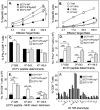
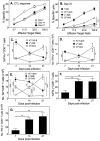

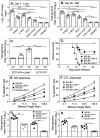
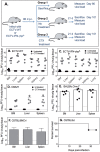
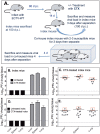
Similar articles
-
Redundant Function of Plasmacytoid and Conventional Dendritic Cells Is Required To Survive a Natural Virus Infection.J Virol. 2015 Oct;89(19):9974-85. doi: 10.1128/JVI.01024-15. Epub 2015 Jul 22. J Virol. 2015. PMID: 26202250 Free PMC article.
-
Deficiency in Th2 cytokine responses exacerbate orthopoxvirus infection.PLoS One. 2015 Mar 9;10(3):e0118685. doi: 10.1371/journal.pone.0118685. eCollection 2015. PLoS One. 2015. PMID: 25751266 Free PMC article.
-
Loss of Resistance to Mousepox during Chronic Lymphocytic Choriomeningitis Virus Infection Is Associated with Impaired T-Cell Responses and Can Be Rescued by Immunization.J Virol. 2020 Feb 14;94(5):e01832-19. doi: 10.1128/JVI.01832-19. Print 2020 Feb 14. J Virol. 2020. PMID: 31826990 Free PMC article.
-
The Pathogenesis and Immunobiology of Mousepox.Adv Immunol. 2016;129:251-76. doi: 10.1016/bs.ai.2015.10.001. Epub 2015 Nov 21. Adv Immunol. 2016. PMID: 26791861 Review.
-
Ectromelia virus: the causative agent of mousepox.J Gen Virol. 2005 Oct;86(Pt 10):2645-2659. doi: 10.1099/vir.0.81090-0. J Gen Virol. 2005. PMID: 16186218 Review.
Cited by
-
Poxvirus-encoded TNF receptor homolog dampens inflammation and protects from uncontrolled lung pathology during respiratory infection.Proc Natl Acad Sci U S A. 2020 Oct 27;117(43):26885-26894. doi: 10.1073/pnas.2004688117. Epub 2020 Oct 12. Proc Natl Acad Sci U S A. 2020. PMID: 33046647 Free PMC article.
-
Comparison of Host Gene Expression Profiles in Spleen Tissues of Genetically Susceptible and Resistant Mice during ECTV Infection.Biomed Res Int. 2017;2017:6456180. doi: 10.1155/2017/6456180. Epub 2017 Dec 21. Biomed Res Int. 2017. PMID: 29430463 Free PMC article.
-
Immune Relevant and Immune Deficient Mice: Options and Opportunities in Translational Research.ILAR J. 2018 Dec 31;59(3):211-246. doi: 10.1093/ilar/ily026. ILAR J. 2018. PMID: 31197363 Free PMC article. Review.
-
Synergistic effect of two human-like monoclonal antibodies confers protection against orthopoxvirus infection.Nat Commun. 2024 Apr 16;15(1):3265. doi: 10.1038/s41467-024-47328-y. Nat Commun. 2024. PMID: 38627363 Free PMC article.
-
Swinepox Virus Strains Isolated from Domestic Pigs and Wild Boar in Germany Display Altered Coding Capacity in the Terminal Genome Region Encoding for Species-Specific Genes.Viruses. 2021 Oct 9;13(10):2038. doi: 10.3390/v13102038. Viruses. 2021. PMID: 34696467 Free PMC article.
References
Publication types
MeSH terms
Substances
LinkOut - more resources
Full Text Sources
Other Literature Sources
Research Materials

